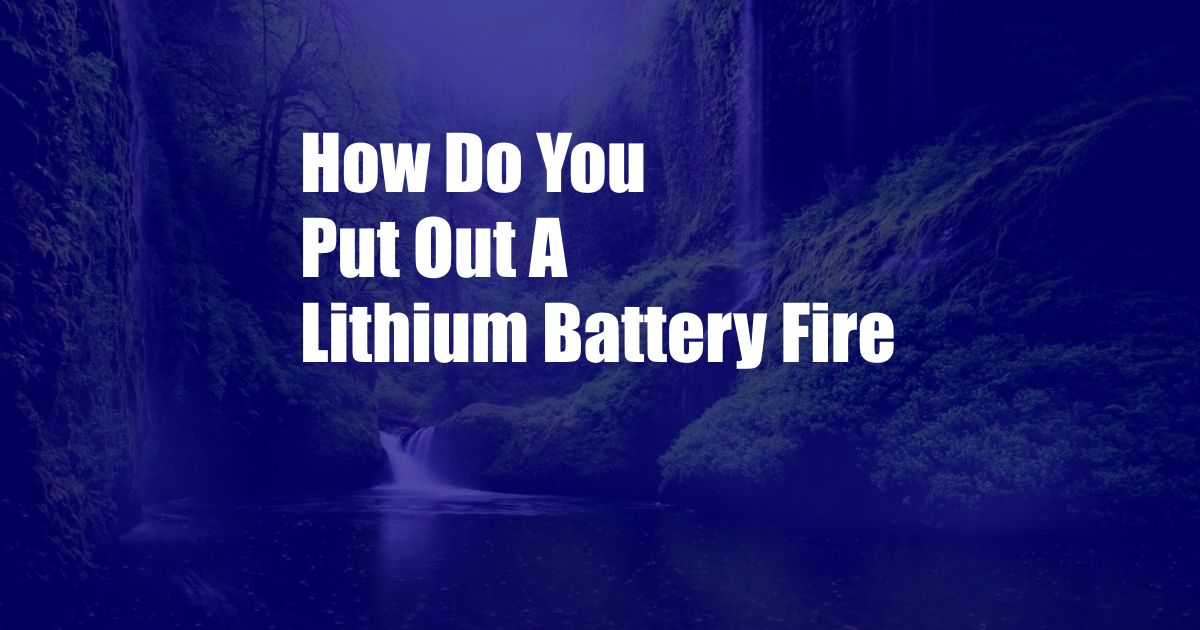
How to Extinguish a Lithium Battery Fire Safely
In the technological landscape, lithium batteries have become ubiquitous, powering various devices from smartphones to electric vehicles. While they offer convenience and high energy density, understanding the potential hazards they pose is crucial. Lithium battery fires can be particularly dangerous due to the presence of flammable electrolytes and the release of toxic gases.
Experiencing a battery fire firsthand can be a harrowing event. A few seconds of distraction while charging my laptop led to a small spark that ignited the battery. Dense smoke billowed from the device, and I quickly realized the gravity of the situation. Knowing the potential consequences, I acted swiftly to contain the blaze.
Fire Safety for Lithium Batteries
Lithium batteries require utmost care to prevent fires. Always handle them with caution, store them in cool and dry places, and ensure proper charging practices using the recommended chargers.
Extinguishing a Lithium Battery Fire
Step 1: Remove Power Source
If possible, disconnect the battery from the power source or the device it’s powering. This will cut off the energy supply and prevent further combustion.
Step 2: Smother the Fire
Cover the burning battery with a fire blanket, thick cloth, or sand. Do not use water, as it can react with the battery and worsen the situation. The covering will deprive the fire of oxygen and help extinguish it.
Step 3: Use a Class D Fire Extinguisher
Class D fire extinguishers are specifically designed for metal fires, including lithium battery fires. Aim the extinguisher at the base of the fire and discharge the contents into the flames.
Step 4: Let it Cool
Once the fire is extinguished, allow the battery to cool down completely before handling it further. Keep it away from flammable materials and place it in a well-ventilated area.
Prevention Tips
1. Proper Charging: Always use the recommended charger and follow the charging instructions carefully. Avoid overcharging or using damaged chargers.
2. Safe Storage: Store batteries in a cool and dry place away from heat sources, direct sunlight, and moisture. Do not store batteries near flammable materials.
3. Damaged Batteries: Never use or charge a damaged or swollen battery. Replace it promptly with a new one.
4. Disposal: Dispose of old or damaged batteries properly at designated recycling facilities. Do not throw them in regular trash.
Expert Advice
“Lithium battery fires are serious but manageable,” says Dr. Emily Carter, an expert in battery safety. “By following proper safety protocols, we can significantly reduce the risk and minimize potential harm.”
Another industry expert, Sarah Jones, emphasizes the importance of fire blankets. “Fire blankets are essential in extinguishing battery fires. They create an oxygen-free environment, effectively suffocating the flames.”
FAQs
Q: What should I do if my lithium battery catches fire?
A: Follow the steps outlined above: remove power source, smother with a non-flammable material, use a Class D fire extinguisher, and let it cool.
Q: Is it safe to put out a lithium battery fire with water?
A: No. Water can react with the battery and worsen the situation.
Q: How can I prevent lithium battery fires?
A: Follow the prevention tips discussed earlier, including proper charging, safe storage, and disposal practices.
Conclusion
Lithium batteries have revolutionized our lives, but their potential hazards cannot be ignored. By understanding how to extinguish a lithium battery fire and following safety protocols, we can ensure safe and responsible use of these powerful energy sources. We encourage our readers to share this valuable information with others and engage in further discussions on lithium battery safety to raise awareness and prevent accidents.
Are you interested in learning more about lithium battery safety? Let us know in the comments below!